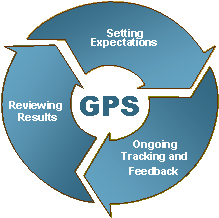 Final Year of GPS
Final Year of GPS
We’ve been sharing the evolution of a new performance management philosophy at Lehigh in Spotlight over the past year and now we’ve reached a critical moment. As we enter the annual review part of the 2016 performance cycle, we will be using GPS for the last time.
GPS forms are being launched for most areas of campus this month. Typically about 70 percent of Lehigh staff complete their annual performance review in January or February.
Even as you are completing your GPS and having your annual meeting with your supervisor, it’s time to turn some attention to the new Performance Draft Book. We sat down with Linda Lefever to discuss the philosophy underlying the Draft Book and some suggestions for how to approach using it for 2017.

The Draft Book Mindset
“If I were to explain the difference in approach between GPS and the Performance Draft Book, it would be that with GPS, you invested time and effort at the end of the year in the form and in one big meeting,” Linda explained. “With the Draft Book, you make that investment upfront, on a quarterly basis, through supervisor-employee conversations and through your notes in your personal Draft Book.”
Since you are meeting with your supervisor quarterly and recording notes for and from those meetings in your Draft Book, Linda says, your annual review is a much simpler process using a two-page feedback form.
“Through the Draft Book and quarterly meetings, our goal is to change Lehigh’s performance management process to a culture of communication,” Linda said. “Quarterly meetings should be two-way conversations, but the employee should be doing most of the talking. Conversations should be about goal setting and about progress toward goals.”
David Joseph has been piloting the Draft Book this year with his employees in Student Auxiliary Services. He describes the mindset this way:
“The draft book provides an opportunity to look towards the future, unlike so many performance reviews where one tends to focus on the past and what someone should improve on,” David said. “The Draft Book allows a year of progressive planning and goal setting. When it comes to the final review portion for the year, the prior meetings and draft book make for an expedited process.”
The Draft Book mindset is also about focusing on Lehigh’s Core Success Factors for staff as an integral part of your performance. These success factors emphasize how you do your work, which is as important as what you do in your work.
 Using the Draft Book
Using the Draft Book
The Draft Book is available on the HR website. Employees: You should download the publication and save it. It’s up to you whether you fill it out on your computer or choose to print it out and write in it by hand.
Supervisors: You should have a Draft Book for your own performance discussions with your supervisor. How you keep notes on the employees you manage is up to you. If you have a system you’ve used in the past that works, feel free to continue that practice. You might also try keeping a Draft Book for each employee you supervise and keeping your notes in those books, which you can then bring to your quarterly discussions.
Getting Started
When you open your Draft Book, you’ll see that the first several pages provide resources to help you put your work into greater context at Lehigh. These resources include the Principles of our Equitable Community as well as Lehigh’s core values.
The next section, pages 5 through 7, will help you familiarize yourself with Lehigh staff Core Success Factors. Pages 6 and 7 offer a deeper dive into the behaviors associated with each success factor.
 Your First Draft Book Homework
Your First Draft Book Homework
Once you’ve reviewed the resources in the first seven pages of the book, it’s time to do a bit of work. Ahead of your first quarterly meeting, which you should plan to schedule for late March, you’ll want to delve into creating an intersection between your key accountabilities and the core success factors.
Linda suggests that you sit down and ask yourself: How do I support Lehigh’s mission and goals in my job? How do I communicate effectively in my job? How am I accountable for work achievements and my own career enrichment? Continue through each of the Core Success Factors until you have described how you embody them in your work.
“You’ll find it is easier than you might think to find ways in which you can demonstrate how the core success factors fit into your daily work,” Linda said.
 Putting it All Together
Putting it All Together
Once you’ve mapped the Core Success Factors to your Key Accountabilities and scheduled your first meeting, you’re on your way. The quarterly discussions are the most important piece of the Draft Book approach. You’ll use pages 12 through 15 to capture your accomplishments, supervisor feedback, and recommendations for enhancing your performance.
At the end of 2017, it will be time to reflect on the whole year. You will have a completed Draft Book from which to draw. Your supervisor will complete the performance feedback form and you have the option of also completing a self assessment before your annual performance meeting.
David thinks the new approach is a welcome change. “Past appraisal processes seemed daunting and many seemed to dread them. Using the Draft Book and various meetings throughout the year allow for accountability and transparency from both an employee and supervisor standpoint.”
